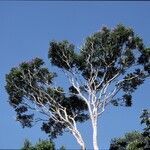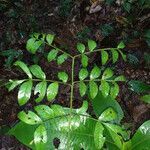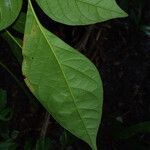Tree to 45 cm d.b.h. and 45 m tall, the trunk usually unbranched for most of its length and often somewhat flattened, young trees unbranched with a cluster of giant leaves at top, bark gray, smooth; twigs lepidote, subtetragonal, drying brown or blackish, the pith large, sometimes hollowed by ants. Leaves pinnately bicompound, 15-165 cm long, with 5-20 pinnae, each pinna 5-35 cm long with essentially wingless rachis and 5-25 sessile leaflets, these 1.5-8 cm long and 0.8-2.5 cm wide, asymmetrically rhombic-elliptic, acute to acuminate, asymmetrically attenuate, membranaceous, secondary veins 3-5 on one side and 4-6 on the other, lepidote with scabrous to puberulous midvein above and be-neath; drying dark brown above, olive beneath, petiole 3.5-29 cm long, the petiolules 2.5-4 cm long, petiole and petiolules lepidote to subpuberulous as on the main and lateral rachises. Inflorescence a narrow terminal panicle, its branches lepidote and subpuberulous to puberulous. Flowers with the calyx cupular, more or less truncate with 5 subequal teeth, pubescent with simple or branched trichomes, 5-7 mm long and 3-5 mm wide, eglandular; corolla purplish-blue outside and on the lobes and abaxially on the throat inside, white adaxially on the throat inside and at the base of 2 adaxial lobes, tubular-campanulate above a 7-10 mm x 3-4 mm basal constriction, 3.2-5.0 cm long and 0.8-1.9 cm wide at the mouth, the tube 2.3-3.7 cm long, the lobes 0.3-1.4 mm long, densely puber-ulent outside with simple, forked, and mostly short dendroid trichomes, the lobes dendroid pubescent inside, the tube glabrous adaxially and pubescent with mostly simple or forked trichomes abaxially, pubescent with gland-tipped trichomes at the level of stamen insertion; stamens didynamous, the anthers 1-thecate, 1.5-2.0 mm long, the anterior filaments 1.1-1.3 cm long, the posterior filaments 0.8-1.0 cm long, inserted 7-10 mm from the base of the tube, the staminode 2.4-2.7 cm long, bifurcate at the tip, glandular-pubescent with long simple trichomes on the tip and central portion; pistil 1.5-1.8 cm long, the ovary flattened-cylindrical, 2-2.5 mm long and 2-2.5 mm wide, 1.5 mm thick, glabrous, the ovules more or less 8-seriate in each locule; disc pulvinate, 1 mm long and 2.5 mm wide. Capsule compressed-oblong, the margins straight, not wavy, 6.2-12.7 cm long and 3.3-6.0 cm wide, somewhat lepidote to glabrous, drying brown or blackish; seeds small-bodied with a surrounding suborbicular wing, 1.0-2.0 cm long and 1.7-2.8 cm wide, the body 3-5 mm long and 3-4 mm wide, the wing hyaline-membra-naceous, with radial brownish striations, clearly demarcated from the seed body.
More
A tall forest tree. The bark is yellow and with narrow cracks. There are small buttresses with wrinkles across them. The leaves are large and opposite. They can be 1 m long. The leaves are compound. There are leaflets with smaller leaflets. The flowers are purple.




